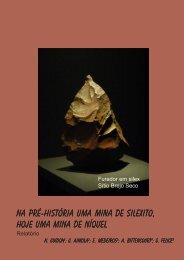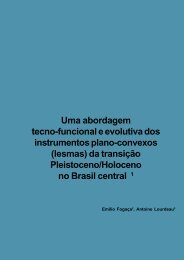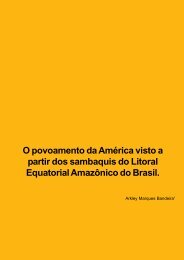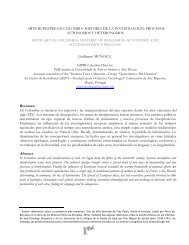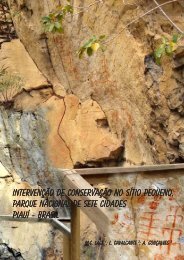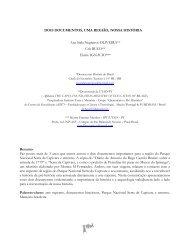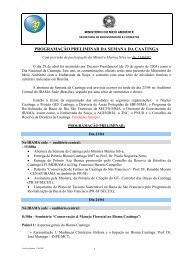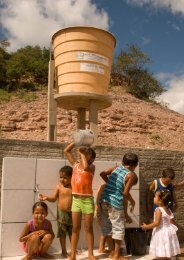Untitled - Fundação Museu do Homem Americano
Untitled - Fundação Museu do Homem Americano
Untitled - Fundação Museu do Homem Americano
You also want an ePaper? Increase the reach of your titles
YUMPU automatically turns print PDFs into web optimized ePapers that Google loves.
Global Rock Art Congress<br />
29 Junho – 3 de Julho 2009<br />
Arte rupestre y ocupaciones del Holoceno tardío en la Patagonia andina (Comarca Andina del<br />
Paralelo 42º, Argentina)<br />
Elena Tropea & Anabella Vasini , Argentina<br />
We will present the results of the analysis of the rock art representations of sites corresponding to<br />
the late Holocene (2.000 years BP in forward) located in the Comarca Andina del Paralelo 42º, that<br />
includes the ecotonal zone forest - steppe of the Patagonian Andes, inside argentinian territory. Using<br />
the microscopical analysis of samples of mineral pigments and of accretions from the rocky support, we<br />
will establish a correlation between the events of execution, production and later transformation of the<br />
rock paintings by the levels of excavation and archaeological material recovered in the Region (Cholila’s<br />
and valley of the Manso river´s sites), in order to define the most late sequence of the rock art and pre<br />
and post hispanic regional.<br />
(Artigo 41 IFRAO2009)<br />
In Situ Pigments Study of Rock Art at Jaguariaíva 1 Archaeological Site (Paraná, Brazil) by Portable<br />
Energy Dispersive x-ray Fluorescence (edxrf)<br />
Carlos Roberto Appoloni, Francisco José Lopes, Fabio L. Melquiades, Wislley Dueli Silva e Cláudia<br />
Ines Parellada, Brasil<br />
Jaguariaíva 1 rockshelter is located in the Jaguariaíva city region, Paraná State, Brazil (17x 21x5.20m<br />
size and 887m high). It is a sandstone shelter with paintings from, at least, two different periods. The<br />
oldest one is around 7.000 years BP. Rock art in the Jaguariaíva 1 shelter is on part of two walls and<br />
ceiling, from 0.5m until 1.90m high at west side, and from 1.80m to 3.60m at north side. The main<br />
<strong>do</strong>cumented panel of the rock shelter has paintings of animals and lattice motifs. The oldest ones are<br />
deer figures infilled with red. The more recent are reddish brown outline figures filled by straight lines.<br />
Rock art regions were analyzed by two portable EDXRF systems, one employing an X-ray tube with Ag<br />
filter and target and another one with an X-ray tube with W target and Ag filter, both with Si PIN diode<br />
detectors and a special designed mechanical system for the detector and X-ray tube positioning, that<br />
enables angular and XYZ movements of the excitation-detection system respect to the measurement<br />
area. Elements from Si to Pb were measured. X-Ray Fluorescence spectra were analyzed using the<br />
AXIL-WinQXAS software.<br />
(Artigo 42 IFRAO2009)<br />
51<br />
Análise Mössbauer de pigmentos de pinturas rupestres de seis sítios arqueológicos <strong>do</strong> Esta<strong>do</strong><br />
<strong>do</strong> Piauí, Brasil<br />
Luis Carlos Duarte Cavalcante, José Domingos Fabris & Maria Conceição Soares Meneses Lage ,<br />
Brasil<br />
The 57 Fe Mössbauer spectroscopy was used in this work on the chemical characterization of pigments<br />
from prehistoric rupestrian art. The measured hyperfine parameters for samples of materials collected<br />
from red paintings are typical of hematite with small particle sizes. Other oxide superparamagnetic<br />
compounds, including goethite, were also detected. This kind of analysis implies several experimental<br />
difficulties, particularly due to the complex chemical composition and to the exceptionally small amount of<br />
samples commonly available for manipulation in the laboratory. Despite of this the chemical-mineralogical<br />
characterization has shown stimulating evidences and detailed information about the mineralogical nature<br />
of these pigments.<br />
Caracterização químico-mineralógica das pinturas e eflorescências salinas <strong>do</strong> sítio de arte rupestre<br />
Pedra <strong>do</strong> Castelo, Piauí, Brasil<br />
Luis Carlos Duarte Cavalcante, José Domingos Fabris & Ma. Conceição Soares Meneses Lage,<br />
Brasil<br />
O Sítio Pedra <strong>do</strong> Castelo é uma gruta com grafismos puros e geometriza<strong>do</strong>s, em diversas tonalidades<br />
de vermelho, e gravuras rupestres nas paredes, teto e assoalho <strong>do</strong>s abrigos. A caracterização químicomineralógica<br />
das pinturas e eflorescências salinas, neste trabalho, foi obtida por (i) espectroscopia<br />
Mössbauer de 57 Fe, (ii) espectroscopia de energia dispersiva,<br />
Parque Nacional Serra da Capivara<br />
Piauí, Brasil




